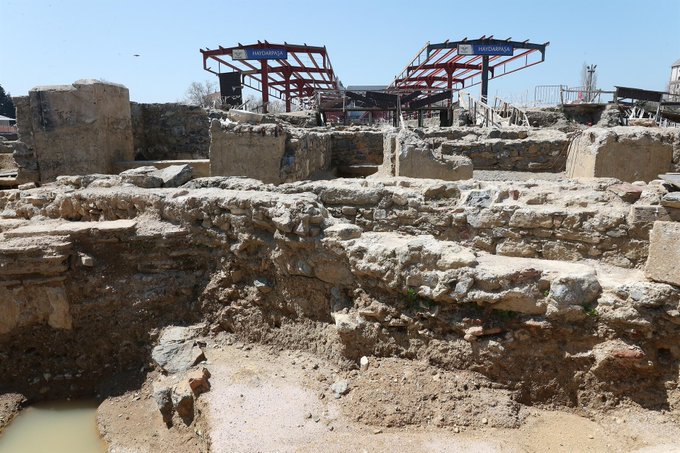
An ancient apse from the fourth or third century BC has just been discovered under a railway station in Istanbul, Turkey.
The apse, forming a semicircular recess, was unearthed as part of the three-year-long archaeological dig at the railway station in the city, which was founded by Byzantine Greeks millennia ago.
The Haydarpaşa Railway Station in Istanbul has given up a number of its historic secrets, going back to Byzantine and Roman times, to the team that has been investigating what lies underneath the structure since May of 2018.
Now, traces of a third- or fourth-century B.C. monument or mausoleum, most likely as part of a religious complex, have been uncovered there.
The Hurriyet Daily News is reporting that Turkish archaeologists have unearthed the remains an apse that may have been a part of an ancient religious structure. Such apses are also part of Christian churches.
Ancient apse is oldest structure found at current site
This architectural gem is the oldest structure discovered at the site up to now.
Excavation leader Mehmet Ali Polat told interviewers from the Demirören News Agency (DHA) that “There is an architectural density here. Most of these are structures were built in the third and fourth centuries A.D.
“Additions were made to these structures in the fifth and sixth centuries.”
The Turkish daily Hurriyet reported that Polat and his team actually uncovered the apse near the station’s train platforms.
Researchers from the Turkish Ministry of Transport and Infrastructure were notified about the significance of the area three years ago, when workers restoring the train hub unearthed ancient artifacts. Archaeologists from the country’s Ministry of Culture and Tourism began working at the site three years ago.
Over the course of these three years, the DHA notes, the researchers have discovered more than 35,000 objects, including large artifacts and architectural columns, in the roughly excavation area — a gigantic area measuring 3.7 million square feet.
It is not known at present why the citizens of ancient Constantinople constructed the apse, but it is most likely that it belonged to a site that was very sacred. Apses in pre-Christian sacred buildings often were used as enlarged niches that would feature the sculpted likenesses of deities.
Other items unearthed in the dig include ceramics and coins from millennia ago, all the way back to the seventh century B.C. and up to the modern era, according to information from DHA.
Part of ancient city of Chalcedon, “Land of the Blind”
Experts believe that the excavations may offer insights into Khalkedon, or Chalcedon, the 2,500-year-old “Land of the Blind,” located on the eastern shore of the Bosporus strait. The ancient city — from which almost no traces remain — has now been subsumed by the modern city of Istanbul.
“This (area) is the northwestern port of the ancient city of Khalkedon, a large structure that could be a warehouse,” Polat explained to Hurriyet. “On the other side of the road, we see a group of buildings that could be a small summer palace.”
The site’s unusual name dates back to approximately 667 B.C., when Byzas of Megara founded the city of Byzantium on the European peninsula of the Golden Horn peninsula, across from Khalkedon, which was located on the Asian side.
Byzas declared that, because Khalkedon’s inhabitants had not settled on the “perfect” peninsula now occupied by his city, they “must have been blind.”
Smithsonian Magazine states in a report that according to World History Encyclopedia’s Donald L. Wasson, the Roman historian Tacitus wrote after the fact that Byzas and his followers had chosen that exact spot for their city after being told to do so by “the god of Delphi,” who advised them to settle down “opposite the land of the blind.”
The area was part of bustling life in the Byzantine Empire until sometime between the fourth and seventh centuries A.D. After that, many of its buildings appeared to become unoccupied and they fell into disrepair.
Polat, the excavation leader, explained to the DHA “Then it gradually became active again in the middle Byzantine period. We know from the remains we have excavated that there were only small workshops here in the late Byzantine period.”
Historians hold out hope that the recent finds will fill in the many missing blanks regarding the long-lost culture of Chalcedon. Jesse Holth, in a column for ARTnews, states that previous archaeological finds, including 10,000 gold coins, the remains of a fifth-century castle and 28 human skeletons, have shown that the once-bustling metropolis most likely had an expansive trade system.
The DHA says that researchers connected to the Istanbul Archaeology Museums undertake approximately 250 excavations in the Turkish city each year.
Last month, Hurriyet reported that Polat and his colleagues had struck the equivalent of archaeological gold when his team discovered a pebble mosaic floor at the site of, incredibly, another train station — that of Kabataş.
That structure was also the later home to the site of Europe’s first canned food factory, a structure built in the late 19th century which canned tomatoes and peas.
Turkish archaeologists have uncovered the ruins of a structure c.C3rd BC during an excavation in #Istanbul’s #Haydarpaşa on the Asian side
These remains give hints about #Khalkedon, the ancient ‘Land of the Blind’ 2,500 years ago https://t.co/zDp5UgPh0L pic.twitter.com/Dy1sqE2Zf8
— Sarah (@Sarah404BC) May 19, 2021
See all the latest news from Greece and the world at Greekreporter.com. Contact our newsroom to report an update or send your story, photos and videos. Follow GR on Google News and subscribe here to our daily email!



